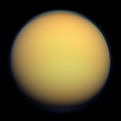Research
My research interests lie primarily in the outer solar system, which hosts abundant icy worlds with subsurface oceans. By studying these worlds through a suite of methodologies, we can learn more about their potentially habitable environments!
The largest moon of Saturn and only moon with a substantial atmosphere, Titan has lakes, seas, and rivers of liquid methane that could freeze into ice.
Perhaps the most promising candidate for alien life, Europa's icy surface has a variety of radiated salts that could teach us about its subsurface ocean.
Despite being demoted, Pluto has one of the most geologically diverse surfaces in the solar system, with processes ranging from ancient mountains to flowing glaciers.

Titan
Titan is one of the most exciting places in the Solar System! This moon has a dense atmosphere, a solid surface harboring lakes, seas, and rivers, and a complex weather cycle analogous to that of Earth. The main difference is that instead of liquid water, Titan's environments are created by liquid methane. My research further explores these alien environments and how the Titan system can be altered by the presence of trace species, including propane, acetylene, and ethylene. I work in the Astrophysical Materials Lab at NAU and collaborate with Lowell Observatory to perform laboratory experiments, ground-based telescope observations, and computational modeling that improve our understanding of Titan's chemical systems.

Europa
Europa hosts an intriguing subsurface ocean composed of saltwater like the oceans we have on Earth. The bottom of Earth's oceans are teeming with life despite experiencing immense pressures and not receiving any sunlight. But hydrothermal vents (where high-pressure water interacts with the silicate mantle of Earth) make for habitable environments where life can thrive. Europa might also host analogous environments at the base of its subsurface ocean. While this subsurface ocean is buried under several kilometers of ice, the presence of irradiated salts on Europa's surface are direct samples from the ocean that we can study more easily. As such, I am working to map the distribution of salts on Europa's surface and connect these regions to morphologic features, radiative processing, and resurfacing events on this amazing moon.

Pluto
Pluto is a geologic wonder that lies in the Kuiper Belt (nearly 40 AU from the Sun!) but still retains enough energy to be geologically active. Its surface hosts a delightful variety of colors and textures, indicative of many compositions and distinct morphologies created by different geologic processes. I aim to better characterize these morphologies through Hapke photometric modeling, which will improve our understanding of Pluto's formation, evolution, and ongoing activity.






